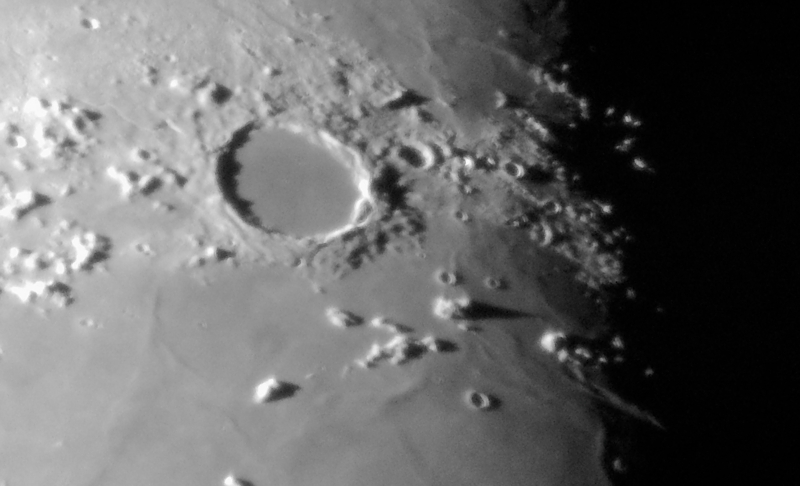
Opposition of Mars
(with credit to H.G. Wells & Orson Welles)
Posted: 9 April 2014
|
Opened: Tuesday, 8 April 2014, 1819 MST Temperature: 93°F |
Session: 671 Conditions: Mostly clear but some clouds in west |
1826 MST: viewed moon, 83X. Took this iPhone 5s handheld afocal 83X photo at 1830 MST:

1832 MST: Some clouds now higher in the sky. Did some lunar observing, 222X. Seeing was not great but the view of the Straight Wall and crater Clavius were nice at times.
Two red-tailed hawks were flying nearby. Got this photo of one of them:

1849 MST: sunset, as seen in this iPhone photo:

1857 MST: tried 444X on the moon but seeing not good enough for that much magnification. 1900 MST: thin clouds were now in much of the sky. Switched back to 222X and took this iPhone handheld afocal photo (cropped) of the Straight Wall and southern terminator, including the crater Clavius, at 1907 MST:

Mouseover or tap on image for labels
1917 MST: viewed Jupiter, 222X. Four moons were visible. At 1925 MST, I began doing iPhone 5s slo-mo video recordings (120 fps) of Jupiter, afocal 666X, using my homemade afocal adapter. This is a stack of 1128 frames:

1930 MST: resumed Jupiter observing, 222X. Then returned to the moon for some more lunar observing, 222X. Began monitoring mountain shadows at Montes Teneriffe.
1944 MST: Mars appeared over the hill to the southeast.
2005 MST: Clouds seemed to be gone. Switched to 444X to observe Montes Teneriffe. This handheld iPhone afocal photo shows the mountains and shadows as well as the large crater Plato:

2026 MST: clouds now visible in the western sky. Seeing worsening at the moon. Switched back to 222X for lunar observing.
2032 MST: began observing Mars, at opposition on 8 April 2014, 222X. It was still low in the southeast. Added one of the Variable Polarizing Filters to reduce the planet brightness. Only the North Polar Cap was visible at this time. 2039 MST: sunset cloud south of the equator became visible. Terrestrial clouds began increasing. 2115 MST: seeing at Mars not improving and terrestrial clouds increasing. While observing Mars I was listening to the Mercury Theater broadcast of "The War of the Worlds". Listen to this description of Mars by Professor Richard Pearson (Orson Welles):
2138 MST: sunrise cloud north of the Martian equator now visible. Seeing was still not very good. Tried 444X; occasionally would get a clear view of the planet but no surface details were visible. By 2200 MST seeing was too bad for 444X. Moved the filter to the 1.25" adapter and used 267X to observe Mars. The view was still very unstable. Terrestrial clouds in the southwest were getting thicker. 2222 MST: thick clouds were now approaching Mars. Decided I had better try imaging the planet before cloud cover became worse.
2230 MST: began doing slo-mo video recordings (120 fps) of Mars, afocal 666X + filter. There was a lot of planet movement during the recordings due to atmospheric conditions. Had a short interruption due to clouds passing in front of Mars. This is a stack of 1127 frames:

Mouseover or tap on image for labels
2245 MST: ended Mars imaging due to clouds. 2252 MST: took a final look at Mars at opposition, 222X and 83X. Seeing not good. Clouds in much of sky.
|
Closed: Tuesday, 8 April 2014, 2303 MST Temperature: 66°F |
|
Comments are welcome using Email. If you are on Twitter you can use the button below to tweet this report to your followers. Thanks.
Cassiopeia Observatory Home Page